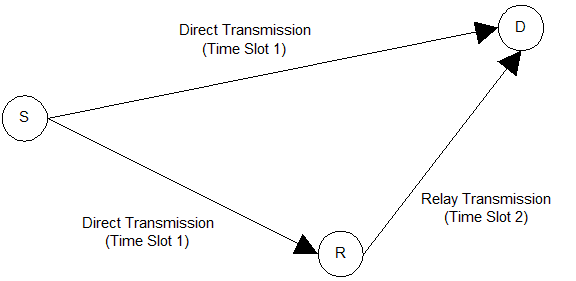
Exploiting Spacial Diversity in Single Antenna Systems using Cooperative Communications. Spatial diversity is traditionally exploited by using multiple transceiver antennas to effectively cope with fading in wireless channels. However, many mobile devices (such as cell phones or PDAs) are not big enough to hold two antennas. The concept of cooperative communications has been proposed to deal with this problem. In cooperative communications, each node is equipped with a single antenna and relies on the antennas of neighboring devices to achieve spatial diversity using a virtual multiple-input single-output (VMISO) variant.
In the Figure, S is the source node, R is the relay and D is the destination. This represents the simplest cooperative scenario with only three nodes. In the first time slot, the source transmits to the destination. At the same time (and over a different fading channel) the relay overhears the transmission. Then in the second time slot, the relay forwards the message to the destination which uses both received messages to jointly decode the data through maximal ratio combining or any of a number of other techniques.
The maximum capacity of this cooperative link is based on the SINR of the joint link, and is given by the equation
| C = ½ BW min(log2(1 + SINRSR), log2(1 + SINRSD + SINRRD)) | (1) |
compared to the capacity of a single (direct) link, which is given by
| C = BW min(log2(1 + SINRSD)) | (2) |
In both (1) and (2), C is the capacity, BW is the bandwidth, and SINRij is the signal to interference and noise ratio from node i to node j. In a realistic network, the main design challenges becomes choosing which relay to use and whether to use a relay at all. Depending on the node placement, there will be many cases where the wrong relay (or any relay) will result in lower capacity than the direct transmission alone, mainly due to the two time slots needed to transmit cooperatively.